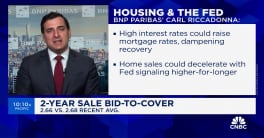Last Saturday I mentioned a misspelling in a mortgage document ("...MERS holds leugal title..."). It turns out that it is not a MERS or Fannie issue, but an Ellie Mae issue. Fannie contacted Ellie, who responded that its staff became aware of the typo on the Oregon document and fixed it in November. Glad to hear it is taken care of!
William Ward said, "The pessimist complains about the wind, the optimist expects it to change, and the realist adjusts the sails." Yesterday we learned that applications for U.S. unemployment benefits declined last week to the lowest level in a month. Analysts can pick apart these numbers all they want, but much of our economy is based on jobs and housing - and both are doing pretty well. (Jobless claims fell by 2,000 to 339,000 in the period ended Dec. 28.) In areas other than residential lending, gains in business and consumer spending should help the U.S. economy.
But things are not so rosy for many companies that base their livelihood on mortgage banking. Apps were decent in October and November, leading to December being a decent funding month. But pragmatic management is looking at estimated fundings for January through March or April, and comparing that to overhead levels, and wondering if more cuts aren't in the cards. And yes, we may see a new HARP cutoff date, or refis come in due to appreciating values, or the purchase market pick up after Easter. But hope is not a strategy.
That being said, as homes appreciate, many who have 30-yr year fixed-rate loans in the 3% range will need cash for the usual reasons. For example, according to the 2013 Houzz & Home Survey, over the last five years nearly 40% of home improvement dollars have gone into kitchens. People spent an average of $28k on kitchen remodels over the past 5Ys and another $10k+ on bathroom renovations.
I know what you're thinking, that we need more Dodd-Frank news. I agree. Back in October of last year, six federal agencies had proposed joint standards for assessing the diversity policies and practices of regulated entities relating to employment and contracting with third parties. The proposal was developed by the agencies' Offices of Minority and Women Inclusion (OMWI). The Dodd-Frank Act directed the Consumer Financial Protection Bureau, Office of the Comptroller of the Currency, Federal Reserve Board of Governors, Federal Deposit Insurance Corporation, National Credit Union Administration, and Securities and Exchange Commission (aka "the Agencies") to establish an OMWI. The Act also required each Agency's OMWI to develop assessment standards for the entities the Agency regulates. The Agencies were seeking comments for the proposal, which were due by December 24, 2013. The CFPB has extended the period for filing comments on its proposed policy statements. The new deadline for filing comments is February 7, 2014.
Dodd-Frank created the Consumer Finance Protection Bureau, which in turn created the Qualified Mortgage criteria. At this point we have five business days until its implementation, and the press is finally taking note of it. If you find yourself in Washington DC on Tuesday, Realtors (through NAR) and CFPB Director will be discussing "New Protections for Homebuyers & the Market Impacts" of QM. It will be held at NAR headquarters, 500 New Jersey Ave. NW on the 12th floor. Presenting will be Chris Polychron, president-elect, National Association of Realtors, Richard Cordray, director, CFPB, Lawrence Yun, chief economist of NAR, and Barry Zigas, director of housing policy, Consumer Federation of America. If you'd like to attend, write to Jenny Werwa at jwerwa@realtors.org. "In advance of the new CFPB mortgage rules going into effect on January 10, 2014, the National Association of Realtors is hosting a discussion about the impacts the rules will have on consumers, lenders and the housing market. The Ability-to-Repay rule establishes strong consumer protections that will ensure qualified homebuyers have access to safe, affordable home loans. Richard Cordray, the director of the Consumer Financial Protection Bureau, will join NAR President-Elect Chris Polychron to deliver remarks at the briefing and take questions."
As a reminder, since there still seems to be some confusion out there, the Department of Housing and Urban Development (HUD) has issued its final rule defining a "Qualified Mortgage" (QM) as required by the Dodd-Frank Act. The new rule, HUD says, builds off of the existing QM rule issued by the Consumer Financial Protection Bureau (CFPB) earlier this year. Like the CFPB QM the new HUD, which applies only to loans insured, guaranteed, or administered by HUD/FHA will go into effect on January 10. In order to be a qualified mortgage as defined by HUD as loan must meet the following requirements: require periodic payments without risky features; have terms not to exceed 30 years; limit upfront points and fees to no more than three percent with adjustments to facilitate smaller loans (except for Title I, Title II Manufactured Housing, Section 184, Section 184A loans and others as detailed below); and be insured or guaranteed by FHA or HUD.
HUD's rule establishes two types of QM. The Rebuttable Presumption QM will have an annual percentage rate (APR) greater than the Average Prime Offer Rate (APOR), the rate for the average borrower receiving a conventional mortgage, plus 115 basis points plus the on-going (FHA) Mortgage Insurance Premium (MIP) rate. Lenders that offer these loans are presumed to have determined that their borrower meets the Ability-to-Repay standard set out in the Truth-in-Lending Act (TILA) but consumers can challenge that presumption by proving they did not have sufficient income to pay the mortgage and other living expenses.
The second type of qualified mortgage is the Safe Harbor QM. These loans must have an APR less that that laid out under the formula above for Rebuttable Presumption loans, and are thought to offer lenders the greatest legal certainty they are complying with TILA. Consumers can still challenge their lender but only on the basis that their loan does not meet Safe Harbor requirements.
HUD has also adopted CFPB's list of transactions that are exempt from the ability-to-repay requirements including Reverse Mortgages; short term (12 months or less) bridge loans, construction to permanent loans, and a list loans available under specialized HUD financing. The new QA rule also covers Title II manufactured housing, Title I manufactured housing and property improvement loans, Section 184 Indian Home Loan Guarantee Program mortgages, and Section 184A Native Hawaiian Housing Loan Guarantee Program mortgages. The rule designates loans insured under these programs as Safe Harbor Qualified Mortgages regardless of upfront points/fees and APR to APOR ratio so as not to interfere with current lending practices until appropriate parameters can be determined.
I remember an equities analyst once commenting on coffee giant Starbucks by saying, "they're hiring more people than any company right now...as if they expect to open up stores on Mars and Venus." Well I'm not too sure about the regulatory climate on other planets, but here on earth the CFPB added an additional 335 workers to their payroll, according to its financial report for 2013. At the end of FY2012, the CFPB employed about 970 individuals; at the end of FY2013 the CFPB had 1,335 employees on staff. During the course of the year, the CFPB received $518.4 million in fund transfers from the Fed (more than three times the $161.8 million in funds transferred in FY 2011 and $175 million more than the $343.3 million transferred in FY 2012). For FY2013, under Dodd-Frank, the CFPB was entitled to receive up to approximately $597.6 million in funding from the Fed. With all the increases in employment and funding, however, the report states "at the end of fiscal year 2013, the CFPB was still below the full employment levels and funding it estimates for its steady state in future years." Maybe they do have plans of interstellar office openings, or at the very least, the CFPB expects to need warm bodies in 2014.
The Office of Inspector General (OIG) has issued a report criticizing the CFPB for bringing enforcement attorneys to exams. In November the CFPB ended its controversial practice of having enforcement attorneys regularly participate in examinations of supervised entities. In the report, the OIG, make a few noteworthy observations on the former practices of the agency: (1) the CFPB's supervision and enforcement staff had varying levels of awareness of the CFPB's policy for how and when enforcement attorneys were to interact with the CFPB's examination teams, (2) the CFPB did not formally train enforcement attorneys on the CFPB's examination process, (3) the CFPB did not have a policy on the ability of enforcement attorneys to access a supervised entity's systems during examinations, and (4) the CFPB has not provided clear guidance to staff regarding the process for resolving legal questions that arise during examinations. In its letter responding to the OIG's report, the CFPB indicated that it agreed with the OIG's recommendation that the CFPB define the roles and responsibilities of all relevant parties with regard to addressing legal questions from examination staff. The CFPB indicated that it "is addressing the concerns raised in this recommendation through its new policy on enforcement attorney integration into examinations."
Hey look, the CFPB doesn't only pick on mortgage originators! Recently, the Bureau has "requested" that financial institutions post on their websites their marketing agreements with colleges and universities for financial products other than credit cards; this would include deposit accounts, prepaid cards and financial aid disbursement accounts. In accordance to the CARD Act of 2009, card issuers must submit their campus credit card agreements annually to the CFPB together with their related marketing agreements, including the amount of compensation they paid to schools; there is no federal law requirement for financial institutions to disclose their marketing agreements or similar information for other financial products. As Ballard Spahr write, "The CFPB's "request" is an outgrowth of the findings on campus financial products it released in October 2013. The CFPB found that campus financial product marketing arrangements have shifted away from credit cards towards student checking and debit or prepaid cards. Most notably, the CFPB found that arrangements between financial institutions and schools to offer student banking products are not well-understood." Full CFPB Monitor posting.
Looking at the markets, rates did a little better Thursday, and we had a little housing news: Pending Home Sales were up .2% in November (the first move higher in five months), and New Home Sales were down 2.1% in November, but is 16.6% above the November 2012. The median sales price of new houses sold in November 2013 was $270,900; the average sales price was $340,300. (Remember that "median" is "half above, half below.") Selling from mortgage bankers averaged below $1 billion per day versus Fed purchases. The are expected to decline just slightly to $2.5 billion area from $2.7 billion based on projected paydowns received in December of $15 billion plus $35 billion in outright purchases for January.
There is no scheduled news of any substance today as the Southwest is dealing with temperatures above 80 degrees and the Northeast just wants to stay home due to snow. Yesterday the 10-yr closed at a yield of 2.99%, and in the early going we're still there at 2.99% and agency MBS prices are worse a tad.







